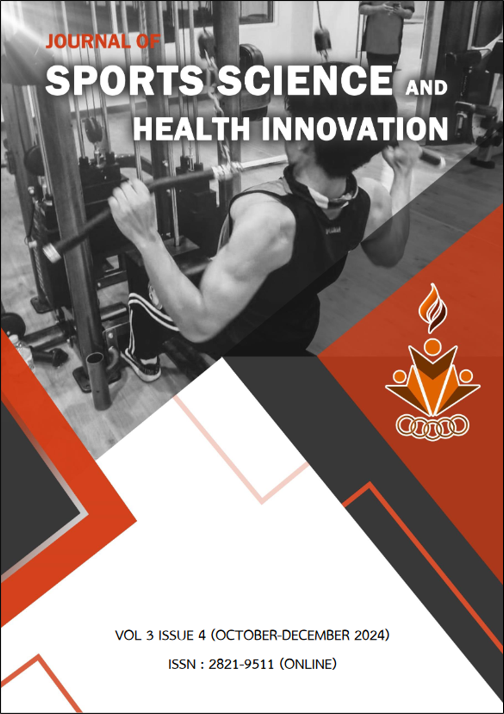ผลของการฝึกความเร็วอดทนแบบมีแรงต้านด้วยยางยืดที่มีต่อสมรรถภาพเชิงแอโรบิก และแอนแอโรบิก ของนักกีฬาฟุตซอลชายระดับมหาวิทยาลัย
Main Article Content
บทคัดย่อ
Article Details
เนื้อหาและข้อมูลในบทความที่ลงตีพิมพ์ในวารสารวิทยาศาสตร์การกีฬาและนวัตกรรมสุขภาพ กลุ่มมหาวิทยาลัยราชภัฏแห่งประเทศไทย ถือเป็นข้อคิดเห็นและความรับผิดชอบของผู้เขียนบทความโดยตรงซึ่งกองบรรณาธิการวารสาร ไม่จำเป็นต้องเห็นด้วย หรือร่วมรับผิดชอบใด ๆ
บทความ ข้อมูล เนื้อหา รูปภาพ ฯลฯ ที่ได้รับการตีพิมพ์ในวารสารวิทยาศาสตร์การกีฬาและนวัตกรรมสุขภาพ กลุ่มมหาวิทยาลัยราชภัฏแห่งประเทศไทย ถือเป็นลิขสิทธิ์ของคณะวิทยาศาสตร์และเทคโนโลยี มหาวิทยาลัยราชภัฏศรีสะเกษ หากบุคคลหรือหน่วยงานใดต้องการนำทั้งหมดหรือส่วนหนึ่งส่วนใดไปเผยแพร่ต่อหรือเพื่อกระทำการใด จะต้องได้รับอนุญาตเป็นลายลักษณ์อักษรจากวารสารวิทยาศาสตร์การกีฬาและนวัตกรรมสุขภาพ กลุ่มมหาวิทยาลัยราชภัฏแห่งประเทศไทย ก่อนเท่านั้น
เอกสารอ้างอิง
Baena-Raya, A., Rodríguez-Pérez, MA., Jiménez-Reyes, P., and Soriano-Maldonado, A. (2021). Maximizing acceleration and change of direction in sport: A case series to illustrate how the force-velocity profile provides additional information to that derived from linear sprint time. International Journal of Environmental Research and Public Health, 18(11), 6140(1-7).
Bakayev, V., & Bolotin, A. (2020). Differentiated training model for marathon runners on building tempo and speed endurance based on the types of energy metabolism. Sport Mont, 18(3), 31-34.
Fang, Q., Zhang, X., Xia, Y., and Huang, F. (2023). Integrating elastic band into physical education classes to enhance strength training. Frontiers in Psychology, 14, 1037736.
Glänzel, MH., Geremia, JM., Couto, AN., et al. (2020). Comparison of aerobic performance indicators of soccer and futsal athletes. Rev Bras Med Esporte, 26(6), 513-516.
Gunnarsson, TP., Christensen, PM., Holse, K., Christiansen, D., and Bangsbo, J. (2012). Effect of additional speed endurance training on performance and muscle adaptations. Med Sci Sports Exerc, 44(10), 1942-1948.
Hostrup, M. & Bangsbo, J. (2017). Limitations in intense exercise performance of athletes – effect of speed endurance training on ion handling and fatigue development. Journal of Physiologhy (London), 595(9), 2897-2913.
Irvine, C., & Taylor, NF. (2009). Progressive resistance exercise improves glycaemic control in people with type 2 diabetes mellitus: A systematic review. Australian Journal of Physiotherapy, 55, 237- 246.
Janusevicius, D., Snieckus, A., Skurvydas, A., Silinskas, V., Trinkunas, E., Cadefau, JA., and Kamandulis, S. (2017). Effects of High Velocity Elastic Band versus Heavy Resistance Training on Hamstring Strength, Activation, and Sprint Running Performance. J Sports Sci Med, 16(2), 239-246.
Krustrup, P., Mahr, M., and Bangsbo, J. (2002). Activity profile and Physiological Demand of Top-Class Soccer Assistant Refereeing in Relation to Training Status. Journal Of Sports Sciences, 20(11), 861-871.
Laia, FM., Thomassen, M., Kolding, H., et al. (2008). Reduced volume but increased training intensity elevates muscle Na+- K+ pump α1-subunit and NHE1 expression as well as short-term work capacity in humans. American Journal of Physiology-Regulatory, Integrative and Comparative Physiology, 294(3), R966-R974.
McArdle, WD., Katch, FI., and Katch, V. L. (2014). Exercise physiology: nutrition, energy, and human performance. Philadelphia: Lippincott Williams & Wilkins.
Mohr, M., Krustrup, P., Nielsen, JJ., Nybo, L., Rasmussen, MK., Juel, C., and Bangsbo, J. (2007). Effect of two different intense training regimens on skeletal muscle ion transport proteins and fatigue development. American Journal of Physiology Regulatory, Integrative and Comparative Physiology, 292(4), R1594-R1602.
Rivière, M., Louit, L., Strokosch, A., and Seitz, L. B. (2017). Variable Resistance Training Promotes Greater Strength and Power Adaptations Than Traditional Resistance Training in Elite Youth Rugby League Players. J Strength Cond Res, 31(4), 947-955.
Sport Science Bureau. (2017). Physical fitness field test Football-Futsal Volleyball Badminton. Bangkok: Sport Science Bureau Institute of Physical Education and Sports Human Development. (In Thai)
Tabata, I., Nishimura, K., Kouzaki, M., et al. (1996). Effects of moderate-intensity endurance and high-intensity intermittent training on anaerobic capacity and VO2 max. Medicine & Science in Sports & Exercise, 28(10), 1327-1330.
Westcott, WL. (2012). Resistance training is medicine: effects of strength training on health. Current sports medicine reports, 11(4), 209–216.
Zagatto, AM., Beck, WR., and Gobatto, CA. (2009). Validity of the running anaerobic sprint test for assessing anaerobic power and predicting short-distance performances. J Strength Cond Res, 23(6), 1820-1827.


